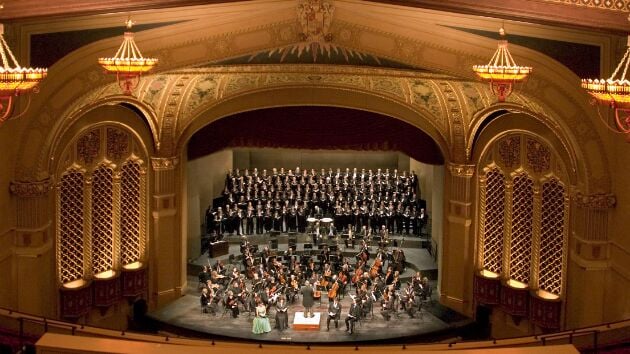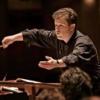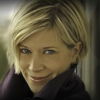
Going into its 16th season without a music director, Symphony Silicon Valley has a regular stable of guest conductors. The only new name on this year’s schedule is Mei-Ann Chen, who conducted last weekend’s set at San José’s California Theatre. I heard the performance on Saturday, Oct. 21. Born in Taiwan, Chen has been a U.S. resident since her teenage years. She’s a vivid and energetic conductor who’s currently music director of the Chicago Sinfonietta, known for its forward-looking programming. SSV’s program on Saturday was hardly innovative, but it showed the greatness of the classics in the right hands.
While Chen was new here, violinist Mayuko Kamio is one of SSV’s most frequent soloists. This was her fifth appearance here in six years. Kamio has a fondness for crowd-pleasing concertos, and her selection this time was both populist and a bit unusual. Aram Khachaturian’s Violin Concerto of 1940 was famous in the days of its dedicatee, David Oistrakh, but since then has fallen into obscurity and only recently has started poking its head up again. It has the same rhythmic vigor and infectious melodies known from Khachaturian’s ballet scores.
Kamio brings a distinctly moaning mid-range tone quality to most of her performances, and that was the case on Saturday. She played with an ultra-dry and unresonant timbre, produced with smooth consistency. Oistrakh had a similar style, actually, but Kamio amps up the technique to 11. This strong and strange sound came off something like a monophonic 78-rpm record played on a first-rate hi-fi system. Kamio proved her purpose intentional by unleashing a kaleidoscope of bizarre tone colors on her encore, Paganini’s 24th Caprice.

The virtuosic demands of the Caprice also reiterated, as if it were necessary, Kamio’s awesome talents as shown in the concerto: her boldness of command, sureness in rhythm and phrasing, richness of harmony in double-stops, and sheer strength. Her vibrato, though not consistently applied, is extremely wide. The concerto, already a long work, seemed absolutely epic in scale but it never dragged. Kamio blazed her trail through it impressively.
There was nothing antique about the orchestra under Chen’s direction, however. Aided by the bright California Theatre acoustics, it was vivid, strong, and entirely up-to-date. The viola and cello sections produced beautiful and full-bodied melodic work. A crisp tang in the winds and percussion gave an exotic flavor to the sound, evoking Khachaturian’s Armenian origins.
There was a similar tang to the orchestra’s opening bonbon, a small bouquet from Dvořák’s Slavonic Dances. (The program said these were from the first set, Op. 46, but in fact only one was from Op. 46 and the other two were lesser-known works from the second set, Op. 72. The program also said they were composed in 1978, a minor error that SSV is prone to.) Rhythmic traction was especially strong here. At the end of the concert, a surprise orchestral encore of Brahms’s Hungarian Dance No. 5 fared equally well.
The remaining highlight was the second half, a bright and clear performance of Brahms’s most introverted symphony, No. 3 in F Major. Chen’s extraverted conducting featured piquant winds and intense, precise strings. Brahms usually fares best with a more subtle and blended sound, but this rendition made up for that difference by being perfectly balanced. It was possible to hear clearly the busy string figures underneath the big brass chorale in the finale without any sense of awkwardness or disproportion. The phrasing, here and throughout, was impassioned and deeply etched. There was no blaring in tutti passages, as happens too often when orchestras push Brahms’s sound out. Technically, the playing was nearly flawless until just before the end when a few missteps crept in, hardly enough to shake confidence in a relatively small symphony orchestra which — at its best, as it was here — plays with the fullness and power of a larger group.





